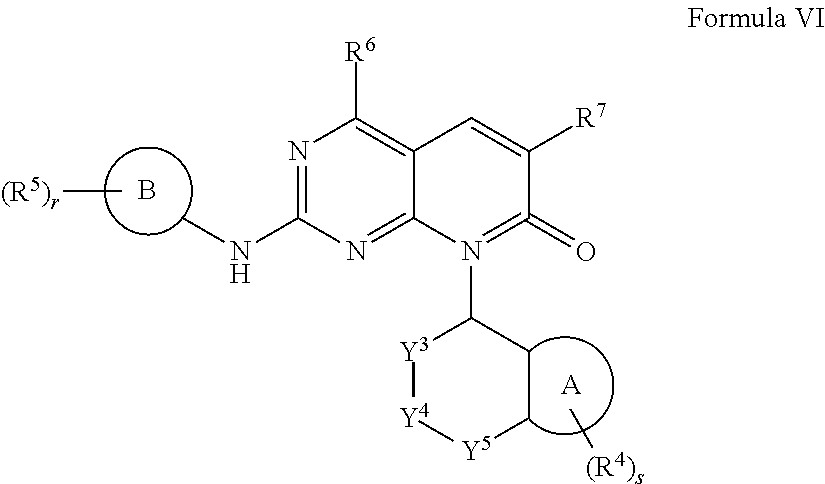Compounds for treating neuropsychiatric conditions
a neuropsychiatric and compound technology, applied in the field of compounding for treating neuropsychiatric conditions, can solve the problems of imposing an enormous health care burden on the society, ncs destroying the quality of life of those affected and their families,
- Summary
- Abstract
- Description
- Claims
- Application Information
AI Technical Summary
Benefits of technology
Problems solved by technology
Method used
Image
Examples
example 1
Synthesis of 8-(7-methoxy-2,3-dihydro-1H-inden-1-yl)-2-(4-(4-methylpiperazin-1-yl)phenylamino)pyrido[2,3-d]pyrimidin-7(8H)-one
[0739]
Intermediate 1: Synthesis of 7-methoxy-1-aminoindane hydrochloride
[0740]
Step 1: Synthesis of 7-methoxyindan-1-one oxime
[0741]To a suspension of 7-methoxyindanone (5.0 g, 31 mmol) and hydroxylamine hydrochloride (12.9 g, 185 mmol) in 100 mL ethanol was added the solution of sodium acetate (11.4 g, 139 mmol) in 35 mL water at room temperature. The reaction mixture was heated at reflux for 4 h, then stirred at room temperature for 18 h. The suspension was filtered, the white solid was washed with water, ethanol and diethyl ether to give the title compound (5.4 g, 31 mmol, 98%). ESMS m / z 178 (M+H)+.
Step 2: Synthesis of 7-methoxy-1-aminoindane hydrochloride
[0742]7-methoxyindan-1-one oxime (2.92 g, 16 mmol) was dissolved in acetic acid (150 mL) and hydrogenated on the H-Cube: 1 mL / min flow rate, 80° C., 100 bar with 10% Pd / C. The reaction mixture was evaporat...
examples 2-26
[0750]The following compounds were made by the method of Example 1 using the appropriate amine at Step 1 and aniline at Step 9. If necessary, the amine was synthesized by the method used for Intermediate 1. Compounds containing secondary amines on the aniline were synthesized using the appropriate Boc protected aminoaniline and in the final step were treated with a solution of hydrogen chloride in an organic solvent to produce the compound, optionally isolated as the hydrochloride salt.
[0751]
No.StructureMWLCMS IonRt2404.54051.873391.53922.644349.43502.685392.53932.486466.64672.887452.64532.828494.54952.899494.54952.7510480.54812.8411466.64672.9012466.64672.9113495.54963.6614508.55092.9215495.54962.9516468.64692.7417470.64712.7618452.64532.9219466.64652.9720483.64842.3421494.64953.3122456.54573.1123470.64713.1524486.64873.1925487.04873.2026498.64993.36
example 27
Synthesis of 8-(2-bromobenzyl)-2-(4-(4-methylpiperazin-1-yl)phenylamino)pyrido[2,3-d]pyrimidin-7(8H)-one
[0752]
Step 1: Synthesis of 8-(2-bromobenzyl)-2-(methylthio)pyrido[2,3-d]pyrimidin-7(8H)-one
[0753]To a suspension of NaH (60%, 47 mg, 1.19 mmol) in anhydrous dimethylformamide (2 mL) was added 2-(methylthio)pyrido[2,3-d]pyrimidin-7(8H)-one (150 mg, 0.78 mmol, prepared by the method in example 1, Steps 1-5, using ammonia in the first step) at room temperature and stirred at 60° C. for 0.5 h. The reaction mixture was cooled down to room temperature and 2-bromobenzyl bromide was added and stirred for 48 h. The mixture was diluted with ethyl acetate (20 mL) and 10% brine solution (10 mL), the two phases were separated, the aqueous layer was washed with ethyl acetate (1×20 mL), the combined organic layer was dried over sodium sulfate, filtered and evaporated to give 8-(2-bromobenzyl)-2-(methylthio)pyrido[2,3-d]pyrimidin-7(8H)-one, an orange oil (0.24 g, 0.66 mmol, 84%). ESMS m / z 362 (M+...
PUM
| Property | Measurement | Unit |
|---|---|---|
| diameter | aaaaa | aaaaa |
| diameter | aaaaa | aaaaa |
| volumes | aaaaa | aaaaa |
Abstract
Description
Claims
Application Information
 Login to View More
Login to View More - R&D
- Intellectual Property
- Life Sciences
- Materials
- Tech Scout
- Unparalleled Data Quality
- Higher Quality Content
- 60% Fewer Hallucinations
Browse by: Latest US Patents, China's latest patents, Technical Efficacy Thesaurus, Application Domain, Technology Topic, Popular Technical Reports.
© 2025 PatSnap. All rights reserved.Legal|Privacy policy|Modern Slavery Act Transparency Statement|Sitemap|About US| Contact US: help@patsnap.com



